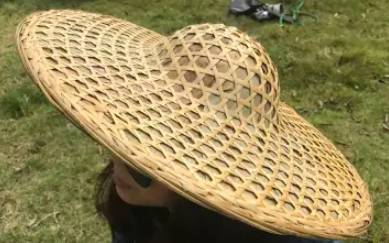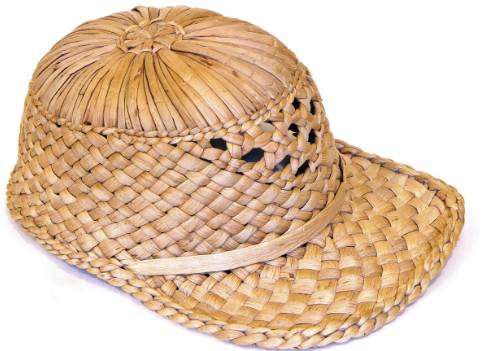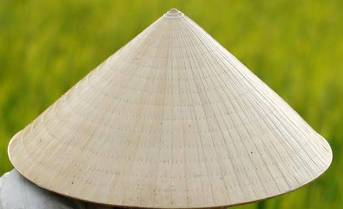Bài học cùng chủ đề
Báo cáo học liệu
Mua học liệu
Mua học liệu:
-
Số dư ví của bạn: 0 coin - 0 Xu
-
Nếu mua học liệu này bạn sẽ bị trừ: 2 coin\Xu
Để nhận Coin\Xu, bạn có thể:

Practice SVIP
Choose the correct answer.
What are traditional headwear in Vietnam?



Read the passage and choose the correct answer to fill in the blank (1).
Conical hats are (1)_________ special craft in Thua Thien Hue province. Recently, local leaders have been working hard to improve the frame of these hats while also protecting the traditional culture. A survey in My Lam village, Phu Vang district, found that in the past, over 300 families there (2)_________ their living by making hats. However, today, fewer than 20 women (3)_________ this tradition, mostly elderly. In Phu Ho commune, Phu Vang district, only 15 households still make these hats.
The (4)_________ in hat makers is due to low and unstable incomes, typically between 30,000-50,000 VND per day, causing many to leave the craft. Another reason is the (5)_________ market for conical hats in Thua Thien Hue. Even at Dong Ba market, where Hue conical hats are popular, only 10-20% are from Hue, with most coming from Quang Binh and Binh Dinh provinces. The Hue Conical Hat Association was (6)_________ in order to protect and promote Hue conical hats.
Read the passage and choose the correct answer to fill in the blank (2).
Conical hats are (1)_________ special craft in Thua Thien Hue province. Recently, local leaders have been working hard to improve the frame of these hats while also protecting the traditional culture. A survey in My Lam village, Phu Vang district, found that in the past, over 300 families there (2)_________ their living by making hats. However, today, fewer than 20 women (3)_________ this tradition, mostly elderly. In Phu Ho commune, Phu Vang district, only 15 households still make these hats.
The (4)_________ in hat makers is due to low and unstable incomes, typically between 30,000-50,000 VND per day, causing many to leave the craft. Another reason is the (5)_________ market for conical hats in Thua Thien Hue. Even at Dong Ba market, where Hue conical hats are popular, only 10-20% are from Hue, with most coming from Quang Binh and Binh Dinh provinces. The Hue Conical Hat Association was (6)_________ in order to protect and promote Hue conical hats.
Read the passage and choose the correct answer to fill in the blank (3).
Conical hats are (1)_________ special craft in Thua Thien Hue province. Recently, local leaders have been working hard to improve the frame of these hats while also protecting the traditional culture. A survey in My Lam village, Phu Vang district, found that in the past, over 300 families there (2)_________ their living by making hats. However, today, fewer than 20 women (3)_________ this tradition, mostly elderly. In Phu Ho commune, Phu Vang district, only 15 households still make these hats.
The (4)_________ in hat makers is due to low and unstable incomes, typically between 30,000-50,000 VND per day, causing many to leave the craft. Another reason is the (5)_________ market for conical hats in Thua Thien Hue. Even at Dong Ba market, where Hue conical hats are popular, only 10-20% are from Hue, with most coming from Quang Binh and Binh Dinh provinces. The Hue Conical Hat Association was (6)_________ in order to protect and promote Hue conical hats.
Read the passage and choose the correct answer to fill in the blank (4).
Conical hats are (1)_________ special craft in Thua Thien Hue province. Recently, local leaders have been working hard to improve the frame of these hats while also protecting the traditional culture. A survey in My Lam village, Phu Vang district, found that in the past, over 300 families there (2)_________ their living by making hats. However, today, fewer than 20 women (3)_________ this tradition, mostly elderly. In Phu Ho commune, Phu Vang district, only 15 households still make these hats.
The (4)_________ in hat makers is due to low and unstable incomes, typically between 30,000-50,000 VND per day, causing many to leave the craft. Another reason is the (5)_________ market for conical hats in Thua Thien Hue. Even at Dong Ba market, where Hue conical hats are popular, only 10-20% are from Hue, with most coming from Quang Binh and Binh Dinh provinces. The Hue Conical Hat Association was (6)_________ in order to protect and promote Hue conical hats.
Read the passage and choose the correct answer to fill in the blank (5).
Conical hats are (1)_________ special craft in Thua Thien Hue province. Recently, local leaders have been working hard to improve the frame of these hats while also protecting the traditional culture. A survey in My Lam village, Phu Vang district, found that in the past, over 300 families there (2)_________ their living by making hats. However, today, fewer than 20 women (3)_________ this tradition, mostly elderly. In Phu Ho commune, Phu Vang district, only 15 households still make these hats.
The (4)_________ in hat makers is due to low and unstable incomes, typically between 30,000-50,000 VND per day, causing many to leave the craft. Another reason is the (5)_________ market for conical hats in Thua Thien Hue. Even at Dong Ba market, where Hue conical hats are popular, only 10-20% are from Hue, with most coming from Quang Binh and Binh Dinh provinces. The Hue Conical Hat Association was (6)_________ in order to protect and promote Hue conical hats.
Read the passage and choose the correct answer to fill in the blank (6).
Conical hats are (1)_________ special craft in Thua Thien Hue province. Recently, local leaders have been working hard to improve the frame of these hats while also protecting the traditional culture. A survey in My Lam village, Phu Vang district, found that in the past, over 300 families there (2)_________ their living by making hats. However, today, fewer than 20 women (3)_________ this tradition, mostly elderly. In Phu Ho commune, Phu Vang district, only 15 households still make these hats.
The (4)_________ in hat makers is due to low and unstable incomes, typically between 30,000-50,000 VND per day, causing many to leave the craft. Another reason is the (5)_________ market for conical hats in Thua Thien Hue. Even at Dong Ba market, where Hue conical hats are popular, only 10-20% are from Hue, with most coming from Quang Binh and Binh Dinh provinces. The Hue Conical Hat Association was (6)_________ in order to protect and promote Hue conical hats.
In Vietnam, people hold incense sticks in pagodas to communicate with the dead. 40 kilometers on the outskirts of Hanoi, there's a village famed for a colorful craft for more than a century: It's Quang Phu Cau Incense Village. Began as a part-time job for villagers besides their farming activity, making incense is now the main income of nearly 10,000 households and consumes more than 20 tons of bamboo a day.
The production includes many steps, from chopping up bamboo, dyeing the incense roots to red, drying naturally under the sun to adding incense paste into the sticks. This paste is a mixture made from an unknown ratio of glue, incense, and bamboo sawdust that exudes a nice scent when burning. In the past, incense making was made manually, but now, mechanization is replacing some processes to increase productivity.
It's not difficult to have beautiful shots when you're here. Space on the sides of roads and courtyards are mostly taken to dry the incense after dyeing. Bunches of incense sticks are spread out to the round shape like hundred bunches of red flowers, giving the village a picturesque look.
Read the passage and decide if each statement is True, False, or Not given.
This handicraft village is located in the suburb of Hanoi.
In Vietnam, people hold incense sticks in pagodas to communicate with the dead. 40 kilometers on the outskirts of Hanoi, there's a village famed for a colorful craft for more than a century: It's Quang Phu Cau Incense Village. Began as a part-time job for villagers besides their farming activity, making incense is now the main income of nearly 10,000 households and consumes more than 20 tons of bamboo a day.
The production includes many steps, from chopping up bamboo, dyeing the incense roots to red, drying naturally under the sun to adding incense paste into the sticks. This paste is a mixture made from an unknown ratio of glue, incense, and bamboo sawdust that exudes a nice scent when burning. In the past, incense making was made manually, but now, mechanization is replacing some processes to increase productivity.
It's not difficult to have beautiful shots when you're here. Space on the sides of roads and courtyards are mostly taken to dry the incense after dyeing. Bunches of incense sticks are spread out to the round shape like hundred bunches of red flowers, giving the village a picturesque look.
Read the passage and decide if each statement is True, False, or Not given.
Making incense has been the main source of income for the locals for hundreds of years.
In Vietnam, people hold incense sticks in pagodas to communicate with the dead. 40 kilometers on the outskirts of Hanoi, there's a village famed for a colorful craft for more than a century: It's Quang Phu Cau Incense Village. Began as a part-time job for villagers besides their farming activity, making incense is now the main income of nearly 10,000 households and consumes more than 20 tons of bamboo a day.
The production includes many steps, from chopping up bamboo, dyeing the incense roots to red, drying naturally under the sun to adding incense paste into the sticks. This paste is a mixture made from an unknown ratio of glue, incense, and bamboo sawdust that exudes a nice scent when burning. In the past, incense making was made manually, but now, mechanization is replacing some processes to increase productivity.
It's not difficult to have beautiful shots when you're here. Space on the sides of roads and courtyards are mostly taken to dry the incense after dyeing. Bunches of incense sticks are spread out to the round shape like hundred bunches of red flowers, giving the village a picturesque look.
Read the passage and decide if each statement is True, False, or Not given.
The incense roots are dyed red, then paste is applied to sticks and dried under the sunlight.
In Vietnam, people hold incense sticks in pagodas to communicate with the dead. 40 kilometers on the outskirts of Hanoi, there's a village famed for a colorful craft for more than a century: It's Quang Phu Cau Incense Village. Began as a part-time job for villagers besides their farming activity, making incense is now the main income of nearly 10,000 households and consumes more than 20 tons of bamboo a day.
The production includes many steps, from chopping up bamboo, dyeing the incense roots to red, drying naturally under the sun to adding incense paste into the sticks. This paste is a mixture made from an unknown ratio of glue, incense, and bamboo sawdust that exudes a nice scent when burning. In the past, incense making was made manually, but now, mechanization is replacing some processes to increase productivity.
It's not difficult to have beautiful shots when you're here. Space on the sides of roads and courtyards are mostly taken to dry the incense after dyeing. Bunches of incense sticks are spread out to the round shape like hundred bunches of red flowers, giving the village a picturesque look.
Read the passage and decide if each statement is True, False, or Not given.
Productivity has increased thanks to the application of machinery in some stages.
In Vietnam, people hold incense sticks in pagodas to communicate with the dead. 40 kilometers on the outskirts of Hanoi, there's a village famed for a colorful craft for more than a century: It's Quang Phu Cau Incense Village. Began as a part-time job for villagers besides their farming activity, making incense is now the main income of nearly 10,000 households and consumes more than 20 tons of bamboo a day.
The production includes many steps, from chopping up bamboo, dyeing the incense roots to red, drying naturally under the sun to adding incense paste into the sticks. This paste is a mixture made from an unknown ratio of glue, incense, and bamboo sawdust that exudes a nice scent when burning. In the past, incense making was made manually, but now, mechanization is replacing some processes to increase productivity.
It's not difficult to have beautiful shots when you're here. Space on the sides of roads and courtyards are mostly taken to dry the incense after dyeing. Bunches of incense sticks are spread out to the round shape like hundred bunches of red flowers, giving the village a picturesque look.
Read the passage and decide if each statement is True, False, or Not given.
The dyed incense is shaped into circles along the roadside to attract tourists.
Choose the correct answer.

Where is it?
Traditional craft villages in Vietnam, mostly found in the Red River Delta, were born from the rice farming practices of the ancient Viet people. During breaks from farming, they crafted tools from bamboo, rattan, and steel. Over time, these individual crafts evolved into village-wide efforts.
Hanoi, Vietnam's capital, is famous for its many craft streets and guilds. The city's 36 streets, all named "Hang," meaning "Craft," are home to various artisans. Some streets, like Hang Bac for silver-making (bac is silver) and Hang Thiec for tin-making (thiec is tin), preserve traditional crafts. Others, like Hang Can and Hang Quat, have lost their original crafts but still hold cultural significance. Each craft village has its own secret, which has been passed down from generation to generation. There have been villages specialized in lacquer wares, pottery, blacksmithing, embroidery, bamboo, rattan, basket-weaving, folk painting and wooden and stone sculpture.
Vietnam now has 4,500 craft villages, including 400 traditional villages which employ some 12 million people and create millions of seasonal jobs for farmers. The export of handicraft items earns more than 1 billion USD annually. These villages generate economic benefits while helping to preserve Vietnam's cultural and historical heritage.
Read the passage and choose the correct answer.
What is the main idea of the passage?
Traditional craft villages in Vietnam, mostly found in the Red River Delta, were born from the rice farming practices of the ancient Viet people. During breaks from farming, they crafted tools from bamboo, rattan, and steel. Over time, these individual crafts evolved into village-wide efforts.
Hanoi, Vietnam's capital, is famous for its many craft streets and guilds. The city's 36 streets, all named "Hang," meaning "Craft," are home to various artisans. Some streets, like Hang Bac for silver-making (bac is silver) and Hang Thiec for tin-making (thiec is tin), preserve traditional crafts. Others, like Hang Can and Hang Quat, have lost their original crafts but still hold cultural significance. Each craft village has its own secret, which has been passed down from generation to generation. There have been villages specialized in lacquer wares, pottery, blacksmithing, embroidery, bamboo, rattan, basket-weaving, folk painting and wooden and stone sculpture.
Vietnam now has 4,500 craft villages, including 400 traditional villages which employ some 12 million people and create millions of seasonal jobs for farmers. The export of handicraft items earns more than 1 billion USD annually. These villages generate economic benefits while helping to preserve Vietnam's cultural and historical heritage.
Read the passage and choose the correct answer.
According to paragraph 2, __________________.
Traditional craft villages in Vietnam, mostly found in the Red River Delta, were born from the rice farming practices of the ancient Viet people. During breaks from farming, they crafted tools from bamboo, rattan, and steel. Over time, these individual crafts evolved into village-wide efforts.
Hanoi, Vietnam's capital, is famous for its many craft streets and guilds. The city's 36 streets, all named "Hang," meaning "Craft," are home to various artisans. Some streets, like Hang Bac for silver-making (bac is silver) and Hang Thiec for tin-making (thiec is tin), preserve traditional crafts. Others, like Hang Can and Hang Quat, have lost their original crafts but still hold cultural significance. Each craft village has its own secret, which has been passed down from generation to generation. There have been villages specialized in lacquer wares, pottery, blacksmithing, embroidery, bamboo, rattan, basket-weaving, folk painting and wooden and stone sculpture.
Vietnam now has 4,500 craft villages, including 400 traditional villages which employ some 12 million people and create millions of seasonal jobs for farmers. The export of handicraft items earns more than 1 billion USD annually. These villages generate economic benefits while helping to preserve Vietnam's cultural and historical heritage.
Read the passage and choose the correct answer.
The word “its” in paragraph 2 refers to _____________.
Traditional craft villages in Vietnam, mostly found in the Red River Delta, were born from the rice farming practices of the ancient Viet people. During breaks from farming, they crafted tools from bamboo, rattan, and steel. Over time, these individual crafts evolved into village-wide efforts.
Hanoi, Vietnam's capital, is famous for its many craft streets and guilds. The city's 36 streets, all named "Hang," meaning "Craft," are home to various artisans. Some streets, like Hang Bac for silver-making (bac is silver) and Hang Thiec for tin-making (thiec is tin), preserve traditional crafts. Others, like Hang Can and Hang Quat, have lost their original crafts but still hold cultural significance. Each craft village has its own secret, which has been passed down from generation to generation. There have been villages specialized in lacquer wares, pottery, blacksmithing, embroidery, bamboo, rattan, basket-weaving, folk painting and wooden and stone sculpture.
Vietnam now has 4,500 craft villages, including 400 traditional villages which employ some 12 million people and create millions of seasonal jobs for farmers. The export of handicraft items earns more than 1 billion USD annually. These villages generate economic benefits while helping to preserve Vietnam's cultural and historical heritage.
Read the passage and choose the correct answer.
The word “employ” in paragraph 3 means _____________.
Traditional craft villages in Vietnam, mostly found in the Red River Delta, were born from the rice farming practices of the ancient Viet people. During breaks from farming, they crafted tools from bamboo, rattan, and steel. Over time, these individual crafts evolved into village-wide efforts.
Hanoi, Vietnam's capital, is famous for its many craft streets and guilds. The city's 36 streets, all named "Hang," meaning "Craft," are home to various artisans. Some streets, like Hang Bac for silver-making (bac is silver) and Hang Thiec for tin-making (thiec is tin), preserve traditional crafts. Others, like Hang Can and Hang Quat, have lost their original crafts but still hold cultural significance. Each craft village has its own secret, which has been passed down from generation to generation. There have been villages specialized in lacquer wares, pottery, blacksmithing, embroidery, bamboo, rattan, basket-weaving, folk painting and wooden and stone sculpture.
Vietnam now has 4,500 craft villages, including 400 traditional villages which employ some 12 million people and create millions of seasonal jobs for farmers. The export of handicraft items earns more than 1 billion USD annually. These villages generate economic benefits while helping to preserve Vietnam's cultural and historical heritage.
Read the passage and choose the correct answer.
Which of the following sentences is not mentioned according to the passage?
Read the passage and match the sentences with the suitable questions.
(1) Phu Lang Pottery Village is known for its unique ceramics. (2) Artisans create pottery pieces using a special clay found in the region. (3) They follow traditional techniques, shaping and glazing the clay by hand. (4) The village produces various items like vases, bowls, and decorative pieces. (5) While it's well-known in Vietnam, its exquisite craftsmanship has also gained recognition worldwide.
Rearrange the passage based on the questions below.
1. What speciality is it?
2. What do people make it from?
3. Do people make it in the traditional way?
4. What can people do with it?
5. Is it well known only in your country or around the world?
a. People can eat com on its own as a snack, or use it to enhance various dishes like desserts or savory meals.
b. Com, a special type of rice in Vietnam, is known for its unique flavor and texture.
c. It is processed traditionally by pounding and roasting.
d. While com is well-known in Vietnam, its fame has spread internationally, attracting food enthusiasts from around the world.
e. It is made from young, soft rice grains.
Rearrange the conversation.
Tuan: Hey Dan, have you ever tried Com tam yet?
Dan: No, I haven't. What exactly is Com tam?
- Wow, it has a lot of toppings. Is it easy to find around here?
- It's a Vietnamese dish made with broken rice, and it's pretty tasty.
- Yeah, you can find it in a lot of local eateries and street food stalls.
- It usually comes with grilled pork, shredded pork skin, and a fried egg on top.
- I'll definitely have to give it a shot. Thanks for letting me know, Tuan.
- Sounds interesting. What's usually served with it?
- No worries, Dan. If you want, we can go together to my favorite Com tam place.
Dan: That sounds great! Let's plan for it soon.
Rearrange the conversation.
Nhung: Hung, are you ready to dive into basket-weaving today?
Hung: Absolutely, Nhung! I'm eager to learn.
- Yes, it'll soften them up and make them easier to work with. Then, let's start weaving.
- I can already picture the beautiful baskets we'll create!
- We lay the strips out in a crisscross pattern, like nature's own puzzle.
- Ah, got it. And then we work our way up the sides?
- Wonderful! Let's begin by gathering some bamboo and rattan.
- Yeah, I have gathered some already. Should we soak them in water first?
- How do we start weaving the base?
- That's right. We'll weave in a traditional pattern, adding our own touch of creativity.


Bạn có thể đánh giá bài học này ở đây